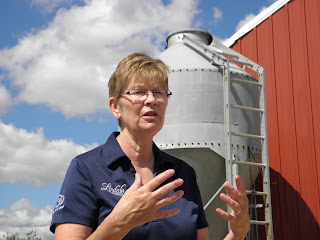 |
| Dairy farming educator extraordinaire, Linda Drendel talks about the farm. |
 |
| Brian J Gerloff, DVM |
 |
| Brian shows us feed for the cows. |
 |
| Beautiful weather for a farm tour. |
The Holsteins on the Drendel farm are monitored and cared for regularly by veterinarian Brian J. Gerloff. Brian has years of experience with dairy cows. He grew up on a dairy farm and began his vet practice caring for dairy cows in 1985. He has witnessed the number of dairy farms in Northern Illinois decrease substantially since he began his practice.
Brian showed us the feed and described how feed is selected for the best nutrition for the cows. What I remember is that a totally mixed ration (TMR) is created to address the nutritional needs of the dairy animals. One of the ingredients is made from the whole corn plant (corn silage), another ingredient is hay. Another fun fact is that cows have four stomachs.
Despite the lovely weather on the day we visited, the cows chose to stay inside. There was an open gate on the side of the barn for them to exit at will, but they remained in the barn. Silly cows.
 |
| Beautiful baby cow. |
Seeing the young ones of any species is usually a treat. The calves were all really beautiful, each with their own distinct markings. They were also generally very friendly.
 |
| Born to latch on. |
 |
| I'm a lactation consultant, but this was a whole new suck assessment. |
Each of the 'City Mom' farm tours has been a delight for me. With the opportunity to meet the farm families, each tour has served as a reminder of just how easy it has become for most of us to buy and consume safe, high quality nutrition for our families. I am grateful for the hard work and dedication of the farmers that goes into making such a wide range of healthy food available to the rest of us.
Following the farm tour, I had the opportunity along with Marla Behrends, from the Midwest Dairy Association, to join radio hosts Rita Frazer and DeLoss Jahnke on R.F.D. Illinois radio to share my experience as a 'City Mom' visiting the Drendel farm. Thanks, Rita and DeLoss, fellow Runza fan, for the opportunity, it was a pleasure talking with you both.
 For a lovely cookbook with great recipes containing dairy, plus a brief introduction to the different breeds of dairy cows, checkout; A Dairy Good Cookbook edited by Lisa Kingsley.
For a lovely cookbook with great recipes containing dairy, plus a brief introduction to the different breeds of dairy cows, checkout; A Dairy Good Cookbook edited by Lisa Kingsley.
No comments:
Post a Comment